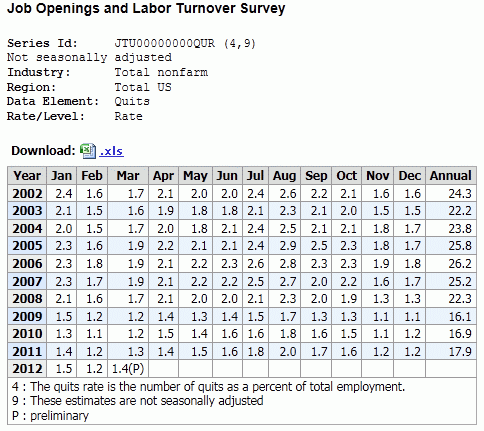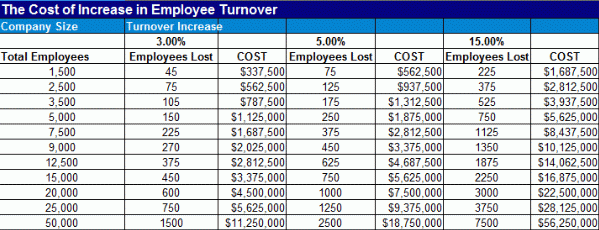Strategic Exit Interviews: Cutting Edge Practices in Exit Interview Management
Webinar Wrap Up – Part One
Nobscot Corporation recently sponsored a webinar,
“Strategic Exit Interviews: Cutting Edge Practices in Exit Interview Management.” It was hosted by Laura DiFlorio, who presented a comprehensive overview of the exit interview process and how HR professionals can reduce turnover through the use of their exit data. It also covered a wide scope of exit interview tips and tactics that HR professionals can use, no matter the size or industry of their organizations.
Cost Of Turnover
Laura began the webinar by giving an example of the cost of turnover. She referenced research in the
“Healthcare Management Review” The Shocking Cost of Turnover in Healthcare that studied Allied Health, a medical organization with 5,000 employees. This organization quantified the total cost of turnover, including the cost to train new employees as well as lost productivity, and learned they were spending between $7 and $9 million dollars per year on turnover costs alone.
Most organizations can look at industry-specific turnover statistics and compare them to their own numbers. Laura directed the webinar participants to the Jolts page on the US Bureau of Labor Statistics (BLS) website,
www.blsl.gov/jlt. This online tool allows HR professionals to view current and historical turnover rates for the United States in a chart format. The chart options include information on both voluntary turnover, as well as involuntary terminations. She pointed out that that the quit rates dropped in the past few years, but they have been rising again in 2012. These rates will most likely continue to increase as the economy starts to rebound.

Laura then presented a chart that HR professionals can use to see how an increase in turnover will affect an organization’s bottom line.

Click for Full Turnover Costs Table
The chart was based on an average turnover cost of $7,500 per employee. She used an example of a company that had 5,000 employees and had an increase of turnover by 5%. This would mean that company would lose an additional 250 employees per year, along with their current losses. Therefore, the company would have to pay for the normal turnover costs, as well as an additional $1,875,000 per year when they experienced a rise in turnover at the 5% rate. The example showed how expensive turnover really is, as well as why HR professionals really need to understand why their employees are leaving.
Success Story
One organization that Nobscot works with was able to cut their attrition by 25% through strategic exit interviews. They had two main goals: reduce turnover and be one of the “Great Places to Work.” This particular organization had 15,000 exempt employees, 24 locations and an annual turnover rate of 57%. After reviewing their exit data, gleaned from Nobscot’s WebExit technology, they learned they had four main root causes of turnover, which included their schedule flexibility, coaching supervision, compensation and the nature of the job itself.
They first tackled the problem by focusing on two of their main issues, scheduling and compensation. After addressing and improving those two areas, they were able to reduce their turnover rates by 25% in two years, which led to the documented savings of $8.4 million dollars in the first year alone.
Turnover Myths
Before jumping into the mechanics of how all organizations can get these types of results through strategic exit interviewing, Laura addressed a few common myths about exit interviews.
1. Once a person puts in his/her resignation, it’s too late. Exit interviews come too late.
The problem with this myth is that many people are confused about the true purpose of exit interviews. Exit interviews are not about the individual people leaving – they are about the organization. They are used not to “save” the resigning employee, organizations can use them to find out information about their company and gather honest feedback so that they can PREVENT other people from leaving.
2. No one is honest in an exit interview.
This myth perpetrates the idea that resigning employees will not be honest in their exit interviews due to fear of burning bridges. Some HR professionals think it’s better to just do employee surveys in lieu of exit interviews. However, the truth is that resigning employees have a lot less to lose by being honest than current employees. According to a Nobscot survey on the topic, 60% of the people said they’d be honest in an employee survey, while 80% of them said they would be likely or very likely to be honest in an exit interview.
Five Main Objectives of Exit Interviews
There are a wide variety of reasons why companies should conduct exit interviews, and here are some of the main ones:
1. Identify why people leave/stay
This reason is typically the most obvious argument for implementing an exit interview process. It is very important for HR departments to find out if their assumptions match up with reality. Exit data allows HR professionals to go to their higher ups with hard data in hand in order to begin to address the organization’s specific issues.
2. Get ideas to improve the organization
HR professionals can gather a wide variety of ideas from exit interviews that they can then use to improve productivity. Some items will be very easy to implement. Many employees will also give the organization ideas about how particular problems can be solved.
3. Early warning risk management detector
Organizations can use exit interviews as tools to identify potential workplace hazards and problems, such as discrimination, sexual harassment and workplace violence. They can use the information to identify brewing problems before they get out of hand and lead to expensive litigation.
4. Measure the success of diversity initiatives
Companies that have these types of programs in place can use exit interview questions to identify what is working and what is not. They can aggregate the data into demographics, such as by race, gender or age to see if all groups are experiencing the workplace the same.
5. Target management training
Some managers are great, and others may need additional training. Exit interview data can help pinpoint which managers may need some extra training or help to get up to par with the rest of the organization.
The next part of the webinar focused on Exit Interview Methodologies, timing of exit interviews, questions to use, reporting and analytics.
Click here to read about these exciting mechanics.
Link to Part Two.
© 2012 Nobscot Corporation. All rights reserved.
If you would like to reprint this article, please contact Kerrie.main@nobscot.com for permission.
Back to Articles



